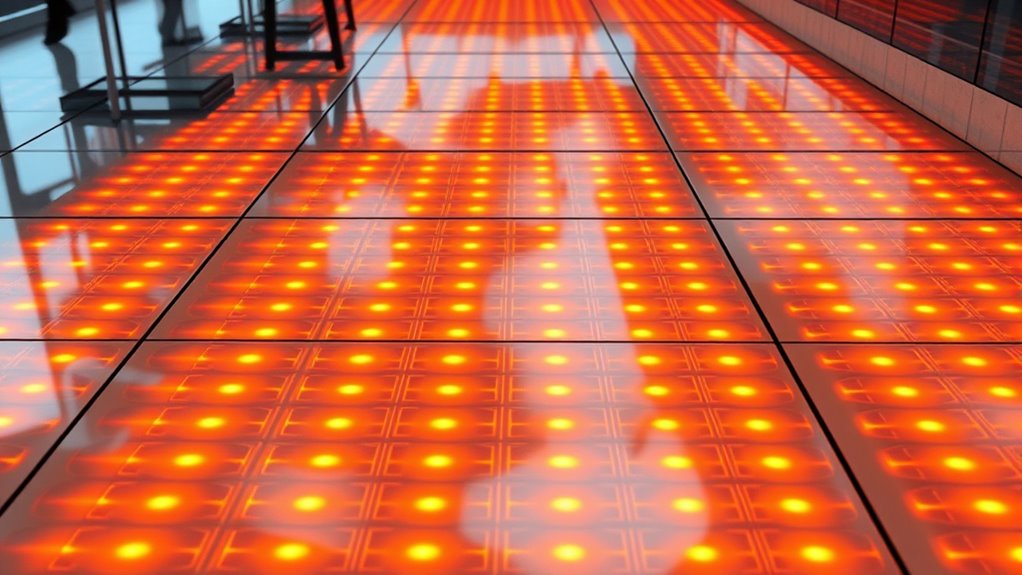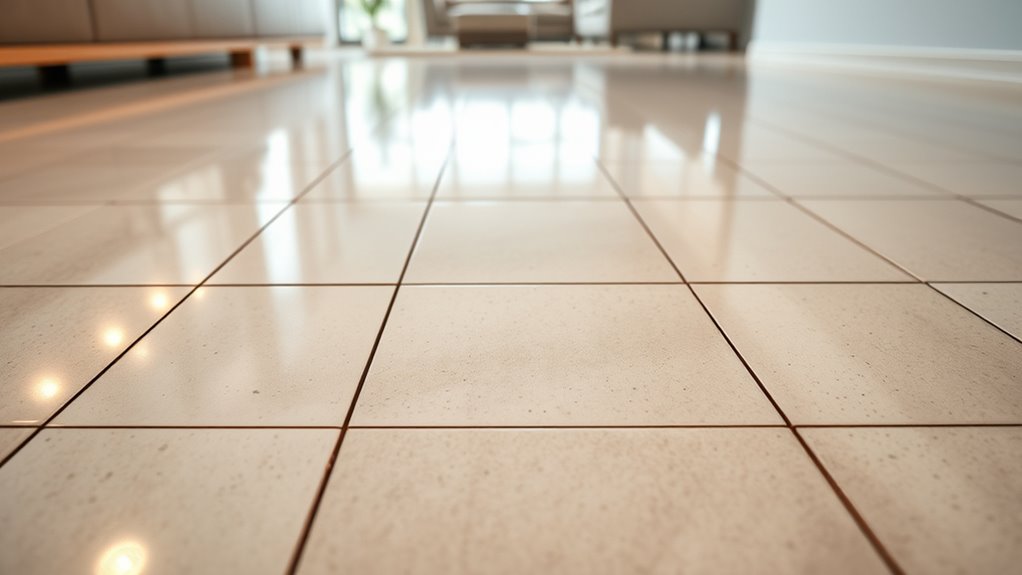When considering radiant floor heating, be aware that long-term costs can add up due to installation challenges, such as retrofitting existing floors and potential repairs for leaks or system failures. Regular maintenance like flushing hydronic systems or updating controls is essential, which can catch you off guard financially. Plus, unforeseen repairs or replacement of components may considerably increase your overall investment. To uncover the full picture and avoid surprises, explore what contractors might not tell you about these hidden expenses.
Key Takeaways
- Retrofitting existing floors for radiant heating can be costly due to removal, subfloor reinforcement, and specialized installation requirements.
- Hydronic systems may incur significant long-term expenses from leaks, mineral buildup, and costly repairs requiring floor removal.
- Regular maintenance of control systems, filters, and flushing is essential to prevent efficiency loss and costly system failures.
- Repairing or replacing damaged flooring or system components can be invasive and expensive, especially if underlying issues are hidden.
- Initial savings may be offset by ongoing maintenance, repairs, and potential system inefficiencies over the lifespan of the heating system.

Radiant floor heating is an efficient way to warm your home by circulating warm water or electric coils beneath the floor surface. While it promises comfort and energy savings, it’s important to understand some hidden long-term costs and practical considerations. One of the main issues you might face involves installation challenges. Installing radiant heat isn’t as straightforward as laying down traditional flooring. It requires careful planning, especially when retrofitting existing structures. You may need to remove or modify existing floors, which can be time-consuming and expensive. If your subfloor isn’t suitable, you might have to reinforce or replace it, adding to the overall cost. Additionally, the installation process often demands specialized skills and equipment, which can drive up labor costs. This complexity could lead to unexpected delays or expenses, especially if your home has unique structural features. Moreover, system design plays a crucial role in ensuring proper performance and efficiency, making professional consultation essential during planning.
Installing radiant heat can be costly and complex, especially when retrofitting existing floors.
Beyond installation, maintenance considerations play a pivotal role in the long-term costs of radiant floor heating. While these systems are generally reliable, they aren’t entirely maintenance-free. Electric systems tend to be simpler, but water-based hydronic systems can develop issues over time, such as leaks or mineral buildup in the pipes. Detecting and repairing leaks beneath the floor can be challenging and costly, often requiring the removal of sections of flooring to access the system. Furthermore, the control systems and thermostats may need updates or repairs as they age, especially if they become incompatible with newer technology. Regular inspections and occasional servicing are necessary to keep everything running smoothly, which adds ongoing expenses you might not initially consider. Proper system maintenance can help extend the lifespan of your radiant heat setup and prevent unexpected breakdowns. Moreover, understanding the installation process beforehand can help you better anticipate potential complications and costs during setup.
Additionally, being aware of filtering and cleaning requirements for any associated air quality systems can prevent dust and debris buildup that might affect system components over time. Proper maintenance ensures optimal operation and helps avoid costly repairs down the line.
Another maintenance consideration involves energy efficiency. Over time, you might find that your system isn’t performing as efficiently as when it was new, possibly due to sediment buildup in hydronic systems or degraded electrical components. Maintaining prime performance may require flushing the system or replacing certain parts, which can be costly. Additionally, if your flooring material isn’t compatible with radiant heat or becomes damaged, repairs can be complicated and expensive. For example, replacing tiles or hardwood over an existing radiant system isn’t just about swapping out flooring; it might involve addressing underlying system issues or reinstallation efforts.
Ultimately, while radiant floor heating offers undeniable comfort and potential energy savings, the installation challenges and maintenance considerations can considerably impact its long-term costs. You need to weigh these factors carefully before investing, ensuring you’re prepared for the potential expenses that come with maintaining this type of heating system over the years.
Frequently Asked Questions
How Much Does Radiant Floor Heating Increase Home Resale Value?
You might wonder how radiant floor heating affects your home’s resale value. Generally, it can boost property appeal by offering modern comfort, but it doesn’t substantially increase resale value unless buyers prioritize energy efficiency. If your area values upgraded features, it can differentiate your home. Keep in mind, the added appeal depends on local market trends and buyer preferences, so it’s worth considering whether it aligns with your neighborhood’s standards.
Are There Hidden Maintenance Costs for Radiant Floor Systems?
Think of your radiant floor system as a delicate garden that needs tending. Hidden repair costs may creep in like weeds, especially as the system approaches its lifespan. While it’s low-maintenance overall, any damage to pipes or controls can lead to costly fixes. Regular inspections help catch issues early, but be prepared for occasional expenses that keep your heating garden thriving for years to come.
Can Radiant Heating Be Installed in Existing Concrete Slabs?
You can install radiant heating in existing concrete slabs, but concrete compatibility and retrofit challenges come into play. Not all slabs are suitable without significant modifications, which can increase costs and complexity. You might need to drill or cut into the concrete, risking damage or uneven heating. It’s essential to evaluate your slab’s condition and consult with professionals to guarantee a proper retrofit that works effectively and lasts long-term.
How Does Climate Impact Long-Term Costs of Radiant Heating?
Your climate can dramatically influence long-term radiant heating costs—it’s like trying to heat a desert in summer! Climate influence means seasonal variations in heating needs, which can skyrocket your expenses in colder regions. If you live in a harsh climate, you’ll likely spend more on energy bills to keep your home comfortable year-round. Understanding how your climate impacts costs helps you plan smarter, saving money over the system’s lifespan.
What Are the Most Common Installation Mistakes Affecting Costs?
You need to watch out for installation errors and improper insulation, as they can substantially increase your long-term costs. Common mistakes include uneven heating due to poor placement of heating elements, or inadequate insulation that causes heat loss. These errors force your system to work harder, raising energy bills and shortening its lifespan. To avoid costly repairs and inefficiency, ensure a professional installs your radiant floor heating with proper insulation and correct placement.
Conclusion
Before you plunge into radiant floor heating, remember it’s not just about cozy toes—it’s about the long game. Hidden costs and maintenance can sneak up like shadows at dusk, turning your warm dream into a costly affair. Think of it as a garden; what seems lush now may require careful tending later. So, weigh the promises against the pitfalls, and make your decision with eyes wide open, because sometimes the brightest flames cast the deepest shadows.
Amina brings over a decade of journalism experience to her role as Editor-in-Chief. Under her leadership, Exquisite Post has flourished, maintaining the highest standards of integrity and excellence. Amina’s commitment to truth and her visionary approach guide the editorial team in producing impactful news stories that resonate with our audience.










